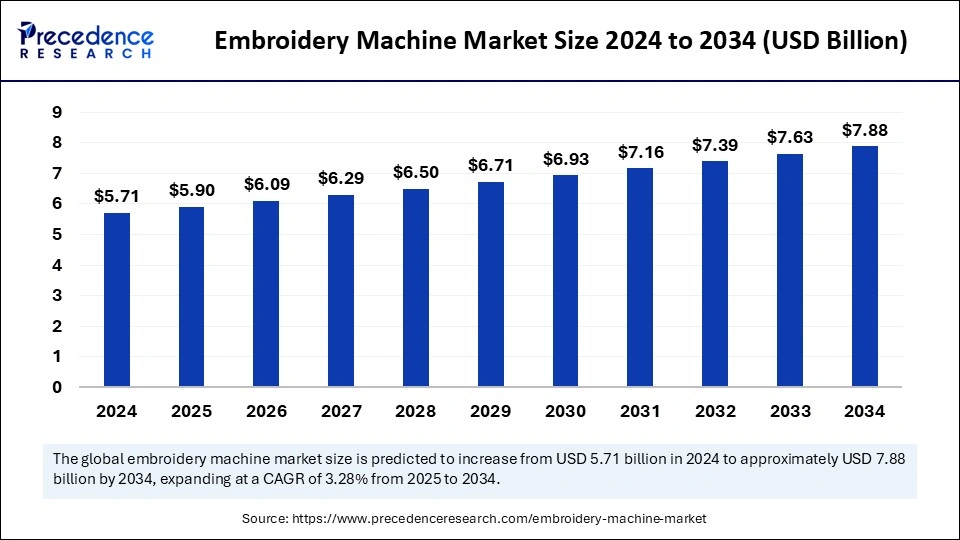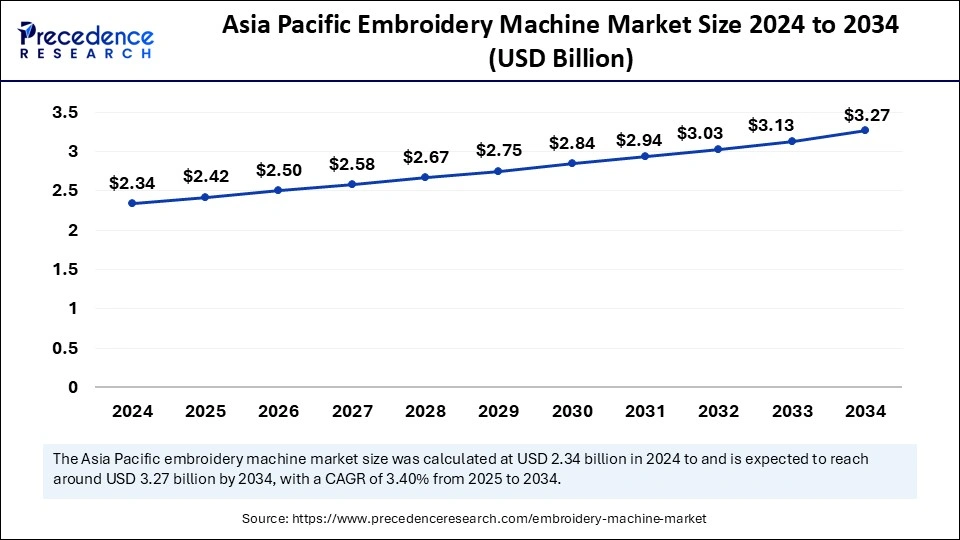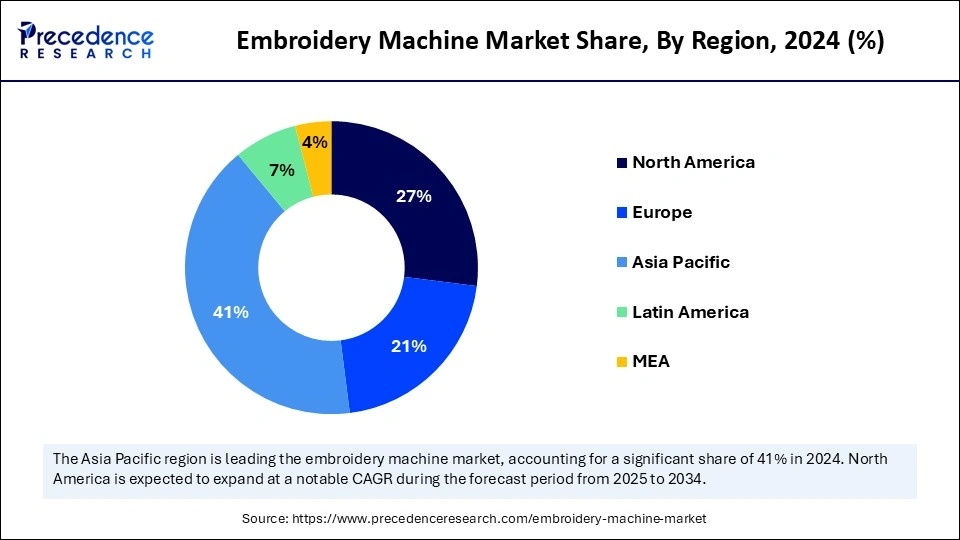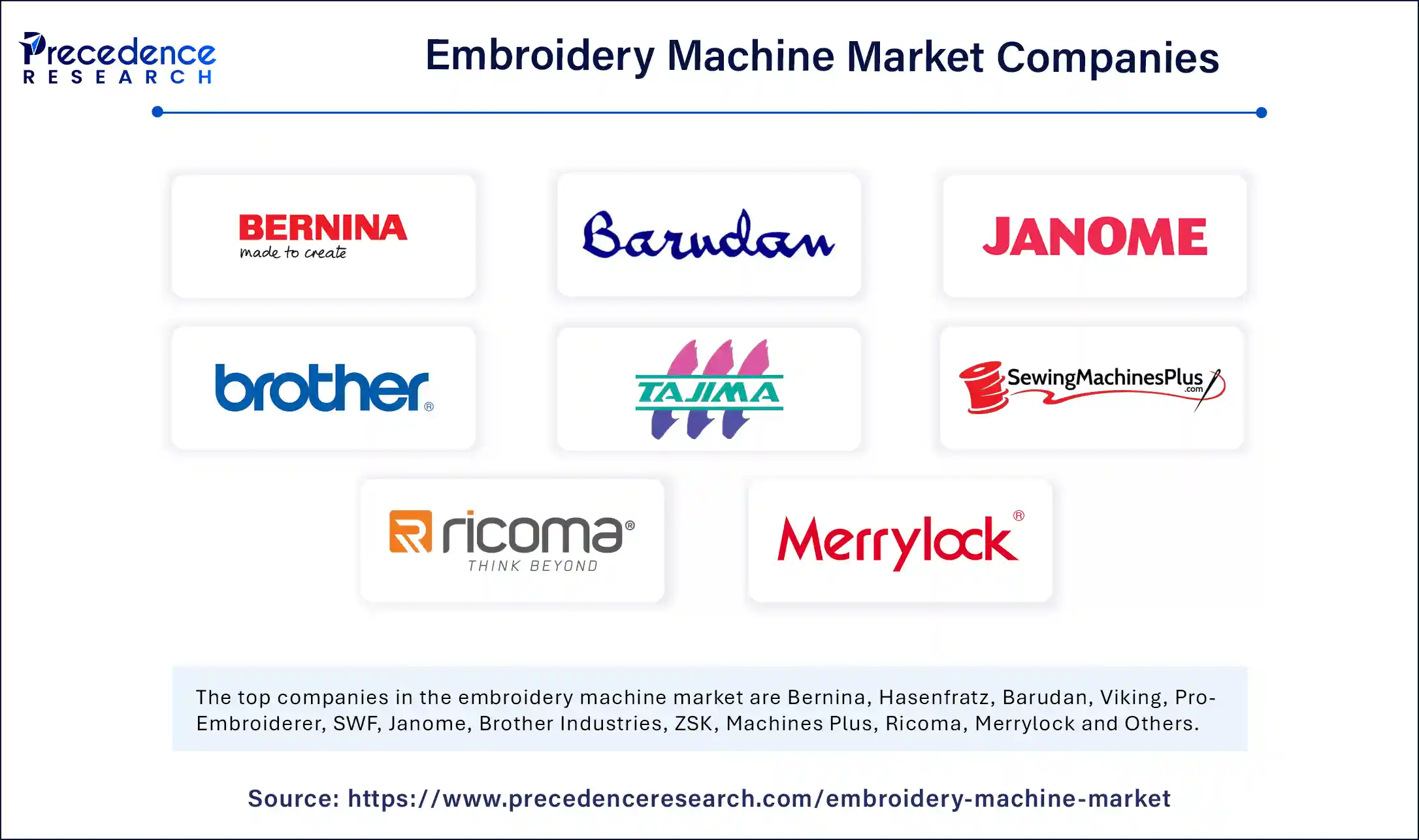September 2024
The global embroidery machine market size is calculated at USD 5.90 billion in 2025 and is forecasted to reach around USD 7.88 billion by 2034, accelerating at a CAGR of 3.28% from 2025 to 2034. The Asia Pacific market size surpassed USD 2.34 billion in 2024 and is expanding at a CAGR of 3.40% during the forecast period. The market sizing and forecasts are revenue-based (USD Million/Billion), with 2024 as the base year.
The global embroidery machine market size accounted for USD 5.71 billion in 2024 and is predicted to increase from USD 5.90 billion in 2025 to approximately USD 7.88 billion by 2034, expanding at a CAGR of 3.28% from 2025 to 2034. The increasing demand for personalized apparel, advanced automation technologies, and government initiatives supporting textile manufacturing.

By elevating automation and accuracy, artificial intelligence is revolutionizing the embroidery machine market. Without human assistance, modern systems can fine-tune thread tension, modify stitch density, and analyze fabric properties. This minimizes material waste and guarantees perfect designs. Large-scale production is made more reliable and effective by machine learning algorithms, which allow embroidery machines to reproduce complex designs with remarkable accuracy. As a result, companies can increase productivity without sacrificing output quality.
Artificial intelligence-powered design tools have made personalization easier. These intelligent systems create patterns, recommend changes, and modify designs according to the material. With the help of user-friendly AI-assisted interfaces, proficient embroidery can be produced even by individuals with no prior embroidery experience. Designers can edit and upload their work from any location due to cloud connectivity, which facilitates smooth collaboration. Custom merchandise and small businesses wishing to provide distinctive made-to-order products will especially benefit from this innovation.
The Asia Pacific embroidery machine market size was exhibited at USD 2.34 billion in 2024 and is projected to be worth around USD 3.27 billion by 2034, growing at a CAGR of 3.40% from 2025 to 2034.

Asia Pacific dominated the global embroidery machine market in 2024 due to the high domestic demand and low manufacturing costs driving embroidered textile production and exports. To keep up with the increasing demand, numerous international producers of embroidery machines have been established in the area. The region maintains its market dominance due to its strong presence in fashion, retail promotional merchandise, and garment manufacturing.
North America is expected to grow at the fastest CAGR in the embroidery machine market over the period studied, driven by a rise in demand for customization home decor and clothing. Companies in the fields of promotional merchandise and custom embroidery are implementing cutting-edge technology. Incorporating embroidery into their business plans is becoming more and more common among independent designers and small-scale entrepreneurs. The market expansion has been greatly aided by the integration of digital embroidery with e-commerce platforms.

The European embroidery machine market is growing at a considerable rate in the market globally due to its rich textile heritage, luxury fashion industry, and focus on sustainability. The area leads the world in the manufacturing of automated high-precision embroidery machines and fuels the demand for luxury couture embroidery. It is leading the way in environmentally friendly embroidery, minimizing waste with digital methods and organic threads. Tradition innovation and sustainability are all balanced by the expanding home decor embroidery market and customization trend, which further positions it as a major player.
The market for embroidery machines is expanding gradually due to consumer demand for personalized clothing, home accents, and branding. While industrial embroidery continues to dominate, computerized and digital machines are becoming more and more popular among hobbyists and small enterprises, and the household segment is growing. The industry is being shaped by innovations such as AI-driven design and environmentally friendly methods.
Cost-effectiveness and sustainability are also being fueled by newer technologies. Artificial intelligence-driven embroidery machines optimize resource utilization, thereby minimizing production waste and excessive thread consumption. Predictive maintenance features help avoid unplanned malfunctions and expensive repairs by anticipating possible technical problems. Through increased productivity and decreased downtime, businesses can lessen their environmental impact and increase productivity. As technology develops, embroidery will become even more intelligent, quicker, and environmentally friendly.
| Report Coverage | Details |
| Market Size by 2034 | USD 7.88 Billion |
| Market Size in 2025 | USD 5.90 Billion |
| Market Size in 2024 | USD 5.71 Billion |
| Market Growth Rate from 2025 to 2034 | CAGR of 3.28% |
| Dominated Region | Asia Pacific |
| Fastest Growing Market | North America |
| Base Year | 2024 |
| Forecast Period | 2025 to 2034 |
| Segments Covered | Machine Type, Technology, Application, End user, and Regions |
| Regions Covered | North America, Europe, Asia-Pacific, Latin America and Middle East & Africa |
Customization is king
Businesses are being forced to invest in cutting-edge machinery due to the growing demand for custom embroidery, which can be used for anything from personalized clothing to distinctive home decor. Nowadays, customers demand unique designs, which makes embroidery essential for branding and fashion. Offering personalized embroidery as a high-end touch, even small businesses and individuals are following the trend.
High-end fashion labels are no longer the only ones embracing customization influences. Small companies and even individual consumers are requesting distinctive embroidered designs for their apparel and accessories. The need for sophisticated, user-friendly embroidery machines has increased because of this change, which has also led to a rise in small-scale embroidery enterprises that serve specialized markets.
Tech powered stitching
AI-powered computerized and digital embroidery machines are simplifying the art of embroidery, enhancing accuracy, speed, and efficiency. The industry is being revolutionized by touchscreen interfaces, wireless design uploads, and real-time customization. AI-assisted pattern suggestions and automatic thread color detection are two recent developments that are pushing creativity to new heights.
The embroidery machine market is heavily reliant on software developments in addition to sophisticated hardware. Designers can now easily collaborate and work remotely due to cloud-based embroidery design platforms and AI-powered pattern generators. In addition to increasing productivity, these developments make it simple for even novices to design intricate embroidery patterns.
High costs and lack of skilled workforce
Advanced embroidery machines are expensive up front, especially the computerized and industrial-grade models. The high barrier to entry prevents many startups and small enterprises from expanding into new markets. Further contributing to long-term costs are replacement parts, software upgrades, and routine maintenance. Large-scale production companies that depend on embroidery may experience operational delays and financial losses because of machine downtime brought on by maintenance or repairs.
A lack of skilled workers capable of managing intricate embroidery design and machine programming plagues many companies in the embroidery machine market. Businesses find it difficult to fully utilize the potential of cutting-edge embroidery technology in the absence of trained operators. For traditional artisans switching from manual embroidery, the learning curve for computerized embroidery software and machine settings is particularly steep. This lack of technical know-how restricts the effectiveness of embroidery machine use and slow adoption rates.
Booming demand for personalized and custom apparel
The need for embroidery machines is being driven by the growth of customized merchandise, corporate branding, and personalized fashion. Businesses that provide embroidery services are seeing great success because of consumers' growing desire for distinctive personalized designs on apparel, accessories, and home decor. With the developments in digital embroidery technology, companies can now provide embroidery services on demand with little setup time. Small embroidery businesses can now reach customers worldwide due to e-commerce platforms, demand services, and social media marketing, making custom embroidery a lucrative niche.
Governmental support
By providing financing incentives to manufacturers investing in high-tech textile machinery, the government encourages the adoption and production of sophisticated embroidery equipment within the county. For instance, the Government of India's Production-linked Incentive (PLI) Scheme for textiles aims to boost domestic textile manufacturing, including the use of advanced machinery such as multi-head embroidery machines. Furthermore, businesses can continually train their employees to operate increasingly complex embroidery machines with training programs and vocational courses made available by the state.
The flatbed segment held a significant share of the embroidery machine market in 2024. In factories that produce home textiles, uniforms, and fashion apparel, flatbed embroidery machines are frequently used for large-scale production. These machines are perfect for mass production because they consistently produce high-quality stitches and perform well on flat fabrics. They are preferred by industries due to their low costs and quick operations, which enable efficient production with few mistakes. Because of their effectiveness in handling large fabric surfaces, they are widely used in household linens and promotional products such as caps and bags and automobile upholstery.
The multi-needle segment is anticipated to grow at the fastest CAGR over the projected period, driven by its ability to work with multiple colors without requiring manual thread changes. Multi-needle machines are becoming more and more popular. Because these machines automate intricate designs, they increase productivity for both small businesses and large factories. They are preferred by custom embroidery companies that work with luxury fabrics, designer apparel, and wedding attire. The popularity of on-demand embroidery services has led to an increase in the number of independent businesses and boutiques purchasing these machines.
In 2024, the computerized segment generated a major embroidery machine market share, driven by their great precision automation and user-friendliness in both commercial and industrial settings. These machines are the market leaders. With little manual labor, users can create intricate and complex embroidery patterns aided by software-driven operations. They are perfect for large-scale production because of their automatic thread-cutting color changes and pattern memory features. For personalized embroidery branding and custom clothing, they are the preferred option due to their integration with CAD systems.
The digital market segment is expected to grow at the fastest rate over the projected period. With AI-powered capabilities that optimize stitching patterns and automatically correct errors, digital embroidery machines are transforming the industry. Wireless connectivity and touchscreen interfaces enable users to remotely upload designs and track production. These devices are ideal for custom embroidery businesses because they can be connected to e-commerce platforms. Additionally, they are being adopted in the field of education, where students studying fashion and textiles use them for learning and prototyping.
The textile segment contributed the highest embroidery machine market share in 2024. Brands are using embroidery to create intricate and one-of-a-kind designs as luxury and personalized fashion trends gain popularity. The need for specialized equipment is increased by the sports industry's heavy reliance on embroidery for team uniform branding and logos; embroidery machines in textiles are now more commercially viable due to the growth of fusion clothing and embroidered streetwear.
The home decor segment is projected to grow rapidly in the coming years, driven by more people looking for rugs, cushion covers, and embroidered curtains, among other personalized home textiles. Demand is being increased by hotels and upscale resorts using embroidered branding on their upholstered linens. With the help of websites like Etsy and Amazon, Handmade, independent designers now have a way to sell decor with custom embroidery. Specialized embroidery machines are becoming more and more in demand as interior designers concentrate on creating distinctive home accessories.
The industrial segment has held the largest embroidery machine market share in the past years, driven by the high demand for precise, fast embroidery machines in commercial settings. The industrial sector is in control. Embroidery is essential to the fashion, furniture, automotive, and promotional merchandise industries for brand customization and differentiation. To boost productivity and lower unit production costs, numerous industries are turning to multi-head embroidery machines. Important customers include fashion labels, interior designers, and hotel chains that use embroidery for furniture detailing, bedding, and curtains.
The household segment is projected to grow at the fastest rate over the forecast period. DIY embroidery projects and home-based businesses have grown in popularity, and household embroidery machines have become increasingly popular. Interest has been stoked by online embroidery courses and YouTube tutorials, which have prompted more hobbyists to purchase equipment. Portable, reasonably priced embroidery machines help small businesses make personalized apparel, presents, and decor. As companies now sell embroidery goods in addition to printed ones, the expansion of print-on-demand services has also played a role.

By Machine Type
By Technology
By Application
By End User
By Geography
For inquiries regarding discounts, bulk purchases, or customization requests, please contact us at sales@precedenceresearch.com
No cookie-cutter, only authentic analysis – take the 1st step to become a Precedence Research client
September 2024
January 2025
October 2024
December 2024